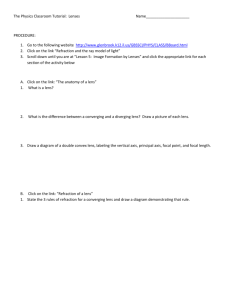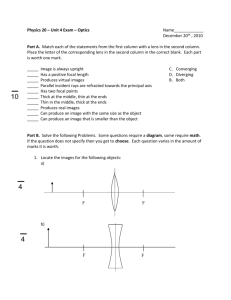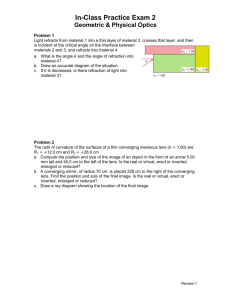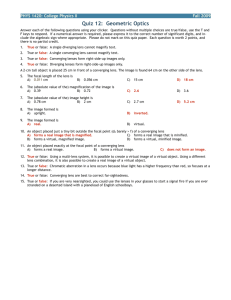Optics-Image Formation Lab
advertisement
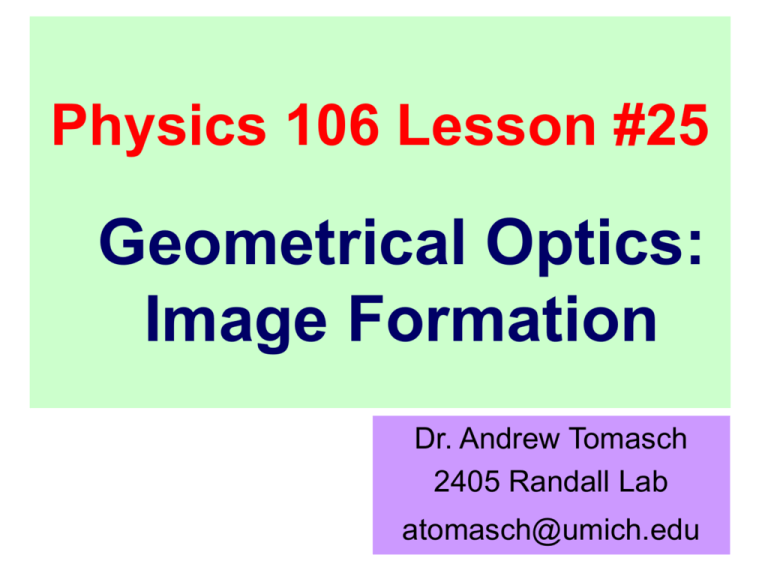
Physics 106 Lesson #25 Geometrical Optics: Image Formation Dr. Andrew Tomasch 2405 Randall Lab atomasch@umich.edu Review: Simple Harmonic Motion (SHM) • For a mass-and-spring oscillator, the oscillation frequency f is governed by inertia (mass) and the restoring force (spring constant) – A bigger mass produces a smaller f (slower oscillation → longer period) – A bigger restoring force (bigger spring constant) produces a bigger f (faster oscillation→shorter period) Hooke’s Law: Fspring= -kx 1 f 2 k m 1 m T 2 f k f is the natural frequency of a mass-and-spring oscillator. Review: The Simple Pendulum •The frequency and period are independent of the mass of the pendulum bob • Assuming g is fixed, the only way to change the period is to change the length of the pendulum •A pendulum with a fixed length can be used to measure g → different f, T on a planet with a different g or at different places on Earth 1 f 2 g 1 L T 2 L f g f is the natural frequency of a simple pendulum. Review: Damping • Damping forces are often put into a system deliberately to prevent it from oscillating indefinitely • Example: the shock absorbers in your car – Too little damping too “bouncy” a ride – Too much damping too “stiff” a ride • Q: How can you tell if a system is underdamped or overdamped? A: Disturb it. If it oscillates for a while it’s underdamped. If it returns to the equilibrium position without oscillating it’s overdamped . Review: Resonance Demo: Mass and Spring on Finger • Natural Frequency: a frequency determined by the physical properties of a vibrating object f driving f natural • Driving an object at its resonant frequency (≡natural frequency) produces high-amplitude oscillations f driving f natural • Objects driven at their natural frequency can be damaged or destroyed Propagation of Light Waves • Light waves arrive at objects and interact with them in three basic ways. They can: 1. Reflect (bounce off) 2. Refract (go through) 3. Be absorbed (stop) • Not exclusive, all three may occur Demonstration Reflection • Specular Reflection Smooth mirror-like surface → rays reflected parallel • Diffuse Reflection Rough surface → rays reflected in various directions The Law of Reflection • The incident ray, reflected ray and the normal to the surface are all in the same plane. • The angle of incidence equals the angle of reflection. i r How Do We See Objects? • Light comes in straight lines from the object to you • Light from different points on the object strikes your retina in different places • An image is a location at which there is a one-to-one correspondence between points on the object and points on the image. Concept Test #1 Why do you see images only in mirrors, and not, for example, in the wall? A. Light is not reflected from the wall B. The law of reflection does not apply to the wall C. Light does not pass through the wall D. The wall isn’t flat enough Plane Mirrors • A ray of light from the top of the chess piece reflects from the mirror • To the eye, the ray seems to come from behind the mirror • Because none of the rays actually emanate from the image, it is called a virtual image Real Images From a Pinhole •The oldest known camera •Used by renaissance artists for one-point perspective drawings •Called the Camera Obscura in classical times Refraction • As light passes from one medium to another it changes direction at the interface between the two media • This change of direction is known as refraction The Index of Refraction • Light travels through materials at a speed less than its speed in a vacuum c c n v v n INDEX OF REFRACTION Indices of Refraction Vacuum 1 (exactly) Air 1.0003 Water 1.333 Ice 1.309 Glass 1.523 Diamond 2.419 Refraction at Surface of Water http://www.opticalres.com/gentsupp_f.html Concept Test #2 While boating on the Amazon, you decide to go spear fishing. You look into the water and see where a fish appears to be. Where should you aim your spear? 1) Beyond where the fish appears 2) In front of where the fish appears 3) Directly where the fish appears What you see Where the fish really is Where the fish really is The Secret of the Archer Fish • Shot with a powerful jet of water, the prey falls into the water and the Archer Fish swims to the surface to retrieve its meal. • The secret to the Archer Fish's success is that it lines up its aim from a position directly underneath the prey. Thin Lenses • Lenses refract light in such a way that an image of the light source is formed • Two types of lenses: converging (convex) and diverging (concave) Converging Lens Diverging Lens A Thin Converging Lens Produces a Real, Inverted Image for Objects Outside the Focal Length A Thin Converging Lens Has a Positive Focal Length-a Real Image can be Produced on the Side Opposite the Object. A Thin Converging Lens Produces a Virtual, Upright Image for Objects Inside the Focal Length A Thin Diverging Lens Produces a Virtual, Upright Image for Objects Outside the Focal Length A Thin Diverging Lens Has a Negative Focal Length—the Image Appears on the Same Side as the Object. A Diverging Lens Cannot Form a Real Image The Thin Lens Equation •Relates the Image Distance (i), the Object Distance (o) and the Focal Length (f) •Works for both Converging and Diverging lenses provided the focal length for a Diverging lens is defined to be negative. 1 1 1 i o f A Typical Camera Lens f/3 Lens f/22 Lens Object Object Film f f Two Cameras With Different f/numbers Film Dispersion • The index of refraction for a given material will vary with the wavelength of the light passing through it • This means that different colors of light will be refracted through different angles when passing through the same medium. • This is called dispersion and can be demonstrated with a prism or by observing a rainbow The Spectrum of a Prism White light is a combination of all the visible colors nr< no < ny < ng < nb < ni <nv Rainbows • Rainbows are a spectacular example of dispersion by droplets of water in the air when the the sun is at your back • Rainbows can be observed when sunlight is refracted and then reflected off the back surface of water droplets The Secondary Rainbow • A secondary rainbow is caused by light which reflects twice inside the drop • The colors in the secondary rainbow are reversed! Primary Rainbow Secondary Rainbow A Double Rainbow…


